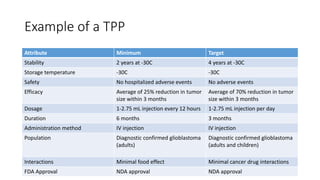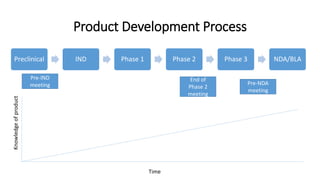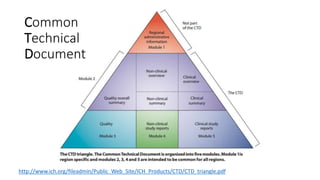1 product development
- 1. Product Development Overview (Regulatory Perspective) Michael Matthews, RAC
- 2. Product Development Overview âĒ Prove the product is safe and effective for the proposed indication âĒ Pharmaceutical products are developed to help treat patients. Always remember that the patients are people and product development must maintain a very high ethical standard. âĒ Risk/benefit âĒ You also have to rememberâĶ âĒ ~$1 - $5 billion taking into account failed products âĒ Highly variable âĒ Drugs for large populations cost more than drugs for rare diseases âĒ Novelty âĒ Hurry up and fail
- 4. Discovery to marketing http://www.phrma.org/innovation/clinical-trials
- 5. An API before and after development 10 years, $1 bil later An API into preclinical studies API after obtaining marketing approval Products do not change during the course of development, you are just learning more about it.
- 6. Target Product Profile (TPP) âĒ The TPP is a document describing the goals and objectives of a product. âĒ It includes a lot of information that will end up on the final label: âĒ Indication and usage âĒ Intended population âĒ Dosage and administration âĒ Dosage form/strengths âĒ Acceptable adverse reactions âĒ Expected or acceptable efficacy âĒ Risk/benefit analyses âĒ It is a living document and expected to be changed as testing progresses
- 7. TPP versus product label âĒ FDA Draft Guidance: Target Product Profile http://www.fda.gov/downloads/Drugs/GuidanceComplianceRegulatory Information/Guidances/ucm080593.pdf Keyruda Approved Label http://www.merck.com/product/usa/pi_circulars/k/keytruda/keytruda _pi.pdf
- 8. Example of a TPP Attribute Minimum Target Stability 2 years at -30C 4 years at -30C Storage temperature -30C -30C Safety No hospitalized adverse events No adverse events Efficacy Average of 25% reduction in tumor size within 3 months Average of 70% reduction in tumor size within 3 months Dosage 1-2.75 mL injection every 12 hours 1-2.75 mL injection per day Duration 6 months 3 months Administration method IV injection IV injection Population Diagnostic confirmed glioblastoma (adults) Diagnostic confirmed glioblastoma (adults and children) Interactions Minimal food effect Minimal cancer drug interactions FDA Approval NDA approval NDA approval
- 9. Preclinical IND Phase 1 Phase 2 Phase 3 NDA/BLA Time Pre-IND meeting End of Phase 2 meeting Pre-NDA meeting Product Development Process
- 10. Break
- 11. Preclinical studies (âIND enabling studiesâ) âĒ In vitro assays âĒ Genotoxicity âĒ Drug interaction âĒ In vivo studies âĒ Pharmacokinetics âĒ Toxicity (rodent and non-rodent) âĒ Pharmacology and proof of concept âĒ Immunogenicity âĒ Other studies??? âĒ More to come on this later *Research/discovery are generally not considered preclinical studies*
- 12. Pre-IND meeting Meeting with FDA to talk about: âĒ Proposed indication âĒ Proposed clinical plan âĒ Summary information of the product âĒ Proposed regulatory pathway âĒ Summary of preclinical studies âĒ Summary of manufacturing âĒ Summary of the proposed clinical study(ies) âĒ Other information Very strict meeting conduct Everything stated can and will be used against you.
- 13. Pre-IND meeting continued âĒ Notify FDA that an IND is coming soon âĒ Get agreement with FDA on certain regulatory concerns âĒ Clinical study design âĒ Preclinical data âĒ Manufacturing methods âĒ Other testing âĒ Get FDAâs valuable comments
- 14. Investigational New Drug (IND) Application âĒ Proposed indication âĒ Example of the investigational product label âĒ Summary of the preclinical and manufacturing information and any known clinical information (focus on clinical risk) âĒ Complete manufacturing information âĒ Where and how product is made âĒ Controls used in the manufacturing process âĒ Stability plan and known stability data âĒ Other information âĒ Complete preclinical reports, including all data âĒ Full clinical protocol âĒ Investigator qualifications âĒ More to come on this later
- 15. Common Technical Document http://www.ich.org/fileadmin/Public_Web_Site/ICH_Products/CTD/CTD_triangle.pdf
- 16. IND Amendments âĒ Required IND amendments âĒ IND Annual Reports âĒ Safety Reporting and updated safety information âĒ Meeting requests/general communications âĒ Updated manufacturing information (stability data, mfg changes) âĒ New clinical study protocols âĒ New nonclinical study reports âĒ New investigators/sites âĒ Other IND amendments âĒ Clinical study reports (CSRs) âĒ IRB approvals âĒ Informed consent forms âĒ Updated investigators brochure or updated foreign market information âĒ Nonclinical protocols
- 17. Nonclinical studies âĒ Animal studies done in parallel with clinical studies âĒ Pharmacokinetics âĒ General toxicity âĒ Chronic toxicity studies âĒ Carcinogenicity âĒ Food effect studies âĒ Reproductive toxicity studies
- 18. Phase 1 clinical studies âĒ 20-80 subjects âĒ Purpose is usually pharmacokinetics or pharmacological effect âĒ A lot of focus on safety âĒ Usually open-label, healthy individuals âĒ Exploratory and can be dose escalation âĒ Usually a lot of analyses, a lot more visits âĒ Product may not be completely âGMPâ âĒ GCP compliant
- 19. Phase 2 Clinical Studies âĒ 200-400 subjects âĒ Usually controlled âĒ Focus on safety âĒ Dose selection or dose determination âĒ Can compare two investigational products to each other âĒ Typically done in target population âĒ GCP compliant
- 20. Phase 3 Clinical Studies âĒ 1000+ subjects âĒ Expected to be controlled and primary focus on efficacy âĒ Evaluate risk-benefit analysis âĒ These studies are to be close to the clinical use of the product âĒ Usually at least 3 batches of product are used to show manufacturing consistency âĒ Need 2 phase 3 studies for marketing approval âĒ GCP compliant
- 21. Marketing application (NDA or BLA) 1. A lot of administrative information âĒ Patenting information, labels and labeling, all of the communications with FDA âĒ Postmarketing commitments and/or REMS 2. Summaries of preclinical, clinical, and manufacturing 3. Extensive manufacturing information 4. Complete preclinical and nonclinical study report (complete data) 5. Complete clinical reports (complete data and a lot of other information)
- 22. Expedited programs for serious conditions Fast Track Breakthrough Accelerated Priority Designation Designation Approval pathway Designation 505(b), FDAMA, FDASIA 506(a), FDASIA CFR314, 601, 506(c) PDUFA Serious + nonclinical data Serious + preliminary Serous + better than or qualified infectious clinical evidence + better available therapy + good disease product than available therapy surrogate endpoint Serious + significant improvement in safety or efficacy or supplement label change or QIPD or voucher Between IND â pre-NDA Between IND â EOP2 Before NDA With NDA or supplement 60 day response 60 day response N/A 60 day response Expedited review and Expedited review and Shorter review clock (6- rolling review rolling review months) http://www.fda.gov/downloads/Drugs/GuidanceComplianceRegulatoryInformation/Guidances/UCM358301.pdf
- 23. Marketing Application Supplements âĒ Annual Reports âĒ Phase 4 or post-marketing studies âĒ Submit reports to FDA on progress of the studies âĒ Submit final reports once studies are completed âĒ Most biopharmaceuticals require post-marketing studies âĒ Safety reporting
- 24. Post-marketing changes âĒ A change in indication most often requires clinical studies to prove efficacy âĒ A change in manufacturing: âĒ If extensive change â pre-approval needed âĒ If moderate change â notify FDA within 30 days âĒ If minor change â notify FDA in an annual report âĒ Labeling/promotional changes âĒ Online ads âĒ TV commercials
- 25. Questions???
- 26. Break time!
- 27. Regulations and Guidance Documents âĒ FD&C Act and other applicable laws: âĒ http://www.fda.gov/RegulatoryInformation/Legislation/FederalFoodDrugand CosmeticActFDCAct/default.htm âĒ All regulations are publically available â FDAâs interpretation of law âĒ http://www.accessdata.fda.gov/scripts/cdrh/cfdocs/cfcfr/cfrsearch.cfm âĒ All guidance (FDA +ICH) publically available â FDAâs current thinking âĒ http://www.fda.gov/Drugs/GuidancecomplianceRegulatoryInformation/Guida nces/default.htm
- 28. Applicable Regulations for Development âĒ 21CFR11 â Electronic Records âĒ 21CFR50 â Human Subject Protections âĒ 21CFR54 â Financial Disclosure by Clinical Investigators âĒ 21CFR56 â Investigational Review Boards âĒ 21CFR58 â Good Laboratory Practices âĒ 21CFR211 and other 200s â Good Manufacturing Practices, labeling, ads âĒ 21CFR312 â Investigational New Drug Regulations âĒ 21CFR314 â New Drug Application âĒ 21CFR316 â Orphan Drugs âĒ 21CFR600s â Biologics
- 29. Applicable Regulations for Development âĒ 21CFR25 â Environmental Impact Considerations âĒ 21CFR200s â Good Manufacturing Practices, labeling, ads âĒ 21CFR312 â Investigational New Drug Regulations âĒ 21CFR314 â New Drug Application âĒ 21CFR316 â Orphan Drugs âĒ 21CFR600s â Biologics âĒ 45CFR46 â HHS Policy for Protection of Human Research Subjects
- 30. GXPs âĒ Good [anything] practices âĒ The common ones (these you have to know): âĒ GLP - Good Laboratory Practices âĒ GCP - Good Clinical Practices âĒ GMP - Good Manufacturing Practices âĒ GDP - Good Documentation Practices (more common in the US) âĒ Lesser used GXP âĒ GDP â Good Distribution Practices (more common in Europe) âĒ GRP - Good Review Practices (used by FDA) âĒ GCLP â Good Clinical Laboratory Practices âĒ GPP â Good Programming Practices
- 31. Good Manufacturing Practices (GMP) âĒ GMPs are meant primarily for the manufacturing process, testing, packaging, and labeling of pharmaceutical substances and products. âĒ GMPs are defined in the regulations under 21 CFR 211 for finished pharmaceuticals. Ensure products are manufactured as to be safe and effective. âĒ Helps prevent products from getting contaminated and helps to ensure products do what they are supposed to do.
- 32. Examples of FDA GMP Guidance Documents âĒ ICH Q7A â Good Manufacturing Practice Guidance for API âĒ ICH Q1A â Stability Testing of New Drug Substances and Products âĒ ICH Q2B â Validation of Analytical Procedures: Methodology âĒ cGMP for Phase 1 Investigational Drugs âĒ Comparability Protocols â Protein Drug Products and Biological Products âĒ Process Validation: General Principles and Practices âĒ Q&A on cGMP for Drugs âĒ Quality System Approach to Pharmaceutical cGMP Regulations http://www.fda.gov/Drugs/GuidanceComplianceRegulatoryInformation/Guidances/ucm064971.htm
- 33. Good Clinical Practices (GCP) âĒ Good Clinical Practices (GCP) are meant primarily for the conduct of clinical studies using any pharmaceutical products. âĒ GCP principles are stated in the laws and regulations which govern clinical studies. All clinical studies must comply with these GCPs. âĒ An international organization known as ICH published the most popular and most used GCP guidance (ICH E6) âĒ Ensures clinical studies are conducted ethically and human subjects are protected âĒ Ensures the scientific integrity of the study http://www.fda.gov/scienceresearch/specialtopics/runningclinicaltrials/default.htm
- 34. Examples of FDA GCP Guidance Documents âĒ ICH E6 â Good Clinical Practice âĒ ICH E3 â Structure and Content of Clinical Study Reports âĒ ICH E9 â Statistical Principles for Clinical Trials âĒ Adaptive Design Clinical Trials for Drugs and Biologics âĒ Alzheimerâs Disease: Developing Drugs for the Treatment of Early Stage Disease âĒ Standards for Clinical Trial Imaging Endpoints
- 35. Good Laboratory Practices (GLP) âĒ Good Laboratory Practices are mentioned by name in the regulations (21 CFR 58) âĒ Meant primarily for animal (in vivo) studies, but may also be referenced for the isolated cell (in vitro) studies âĒ Ensures quality study design and the study is conducted in an ethical and appropriate matter âĒ Ensure scientific integrity of the data collected
- 36. Examples of FDA Preclinical Development Guidance Documents âĒ Good Laboratory Practices Q&A âĒ ICH S1A â The Need for Long-term Rodent Carcinogenicity Studies âĒ ICH S2 â Genotoxicity âĒ ICH S3 â Toxicokinetics/pharmacokinetics âĒ ICH S4 â Chronic Toxicity âĒ Product Development Under the Animal Rule âĒ Immunogenicity Evaluation of INDs âĒ Nonclinical Safety Evaluation of Drug or Biologic Combinations âĒ Safety Testing of Drug Metabolites
- 37. Good Documentation Practices (GDP) âĒ GDPs is an industry term used to define how documentation should be done in a regulated environment âĒ Applies to all disciplines: manufacturing, preclinical, and clinical âĒ Ensures all information is captured accurately and all changes are captured and traced. âĒ Mostly applies to handwritten documents (batch records, handwritten medical records, or handwritten results from assays). âĒ For electronic documentation, a different term is usedâĶPart 11 âĒ ALCOA (attributable, legible, contemporaneous, original and accurate)
- 38. Other Examples Useful Guidance Documents âĒ Part 11, Electronic Records; Electronic Signatures â Scope and Application âĒ ICH M(series): Electronic Common Technical Document (submission standards) âĒ Providing Submissions in Electronic Format â Standardized Study Data âĒ Format and Content of Proposed Risk Evaluation and Mitigation Strategy (REMS) âĒ Formal Meetings Between the FDA and Sponsor âĒ Pharmacogenomic Data Submissions âĒ Target Product Profile
- 39. More Resources âĒ Manual of Policies and Procedures (MAPP) âĒ http://www.fda.gov/aboutfda/centersoffices/officeofmedicalproductsandtob acco/cder/manualofpoliciesprocedures/default.htm âĒ Staff Manual Guides (SMG) âĒ http://www.fda.gov/AboutFDA/ReportsManualsForms/StaffManualGuides/de fault.htm âĒ Data standards âĒ http://www.fda.gov/ForIndustry/DataStandards/ âĒ Orphan Drug Designations and Approvals âĒ http://www.accessdata.fda.gov/scripts/opdlisting/oopd/ âĒ Standards Organizations âĒ USP, CDISC, OECD, HL7, CMS, ICD-9CM(10CM)
- 40. And More Resources (specific products) âĒ Warning Letters âĒ http://www.fda.gov/iceci/enforcementactions/WarningLetters/default.htm âĒ Clinical Investigator Inspection Search/BIMO âĒ http://www.accessdata.fda.gov/scripts/cder/cliil/index.cfm âĒ http://www.accessdata.fda.gov/scripts/cder/bmis/index.cfm âĒ Drugs@FDA âĒ http://www.accessdata.fda.gov/scripts/cder/drugsatfda/ âĒ Public Meetings and Advisory Committee Meetings âĒ http://www.fda.gov/AdvisoryCommittees/CommitteesMeetingMaterials/default.htm âĒ ClinicalTrials.gov âĒ www.clinicaltrials.gov âĒ Patents âĒ http://patft.uspto.gov/






























![GXPs
âĒ Good [anything] practices
âĒ The common ones (these you have to know):
âĒ GLP - Good Laboratory Practices
âĒ GCP - Good Clinical Practices
âĒ GMP - Good Manufacturing Practices
âĒ GDP - Good Documentation Practices (more common in the US)
âĒ Lesser used GXP
âĒ GDP â Good Distribution Practices (more common in Europe)
âĒ GRP - Good Review Practices (used by FDA)
âĒ GCLP â Good Clinical Laboratory Practices
âĒ GPP â Good Programming Practices](https://image.slidesharecdn.com/1productdevelopment-141209195430-conversion-gate02/85/1-product-development-30-320.jpg)









